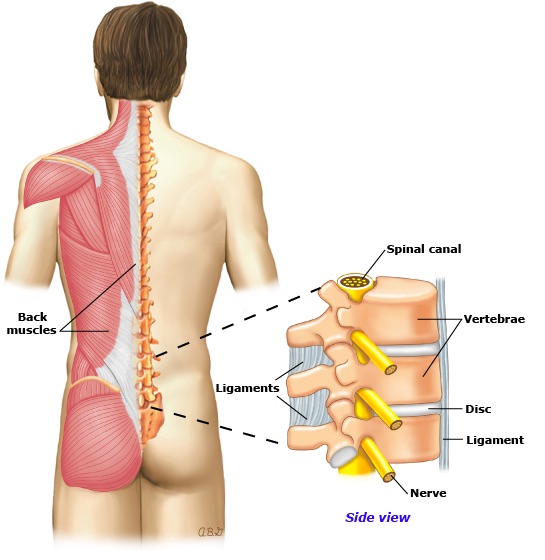Do you have sharp, shooting back pain? Numb legs? Tingling feet? It could be sciatica.
What Is Sciatica?
Sciatica is a condition characterized by pain in the lower back, leg, and hip due to irritation or compression of the sciatic nerve. It is essentially an umbrella term for any radiation of pain down the back of the leg. However, this tells you nothing about the pain or injury origin. Finding the source of sciatica is the most important step in relieving your pain.
The sciatic nerve is the largest and longest spinal nerve in the human body. It runs from the lower back down the back of each leg. Its role is to transmit nerve signals between the muscles and the legs and feet. It sends signals from the brain to the muscles of the legs to move and receives single such as sensation or pain rom the legs and feet. Pain occurs when something injures, or puts pressure on, the sciatic nerve. This does not have to be a physical crossing or pinching injury to the nerve, but can also be sensitization of the nerve.
There can be several origins of sciatic pain. Some of the more common causes are listed below however, this list is not exhaustive:
- Dural tension (tension of the tissue surrounding the nerve)
- Disc herniation or “bulge”
- Piriformis syndrome
- Lateral stenosis of the spine
- Traumatic injury
- Sitting on improper surfaces for long periods of time
The important thing to remember here is that once the sciatic nerve has been sensitized, it becomes “hyper-sensitive” which means it over reacts to normal stimuli. For example, if you think about a sunburn, normally when you try to get dressed or have a shower it isn’t painful. But when you have a sunburn those same activities become very painful.
Do You Have Sciatica?
Sciatica is rather common, however, not everyone who experiences sciatic-like pain is actually suffering from true sciatica. When someone suffers from sciatica the symptoms are clear. A sharp pain radiates along the sciatic nerve from the lower back down the buttocks, back of the leg, calf, and even down to the foot. It is a nagging and disruptive pain and it seems as though no position is helpful.
Everyone experiences sciatic pain at different levels. The pain associated with sciatica can range from an inconvenient distraction or discomfort to a debilitating one. It can be described as moderate to excruciating.
Sciatica Symptoms
Sciatica symptoms are easy to identify, however the cause of sciatic can be difficult to determine. Although symptoms can show up in both legs, it’s more common for sciatica to only affect one side of the body. Symptoms include:
o Mild or severe radiating pain down the leg and into the foot
o Sharp, shooting pains in the side of the hip, the outer thigh, the calf and/or foot
o Numbness in the lower extremities
o Pins and needles in the legs and/or feet
o A burning sensation in the lower body
o Muscle weakness in the affected leg
o Lower back pain

Common Causes of Sciatica
Sciatica is an irritation of the sciatica nerve producing pain in the nerves, buttock and leg. It can occur as a result of the compression of the spinal nerves (radiculopathy) in the lower lumbar region of the spine, or of the sciatic nerve in the buttock region known as Piriformis Syndrome. Sciatica is relatively easy to identify, however that cause of sciatic is the more challenging part when determining the appropriate intervention or treatment.
Herniated Disc: The most common cause of true sciatica is a herniated disc. This occurs when a spinal disc, that lies between each vertebrae in your spine weakens, and its jelly-like contents are pushed out (i.e., herniated or extruded) and press against the root of the sciatic nerve.  The pain that stems from this pressure is called sciatica. This compression causes a radiating pain that affects the lower back, hip, and outer leg.
The pain that stems from this pressure is called sciatica. This compression causes a radiating pain that affects the lower back, hip, and outer leg.
Piriformis syndrome: This is also characterized by pain in the sciatic nerve. This is a commonly misdiagnosed condition where the sciatic nerve is being compressed by spasms of the piriformis muscle, a small muscle located at the side of the buttocks, directly across the sciatic nerve. Piriformis syndrome can be hard to identify and is often diagnosed only when true sciatica is ruled out as a cause.
Degenerative Spinal Arthritis: Osteoarthritis of the spine breaks down the cartilage on the joints and discs in the neck and lower back. This can produce bone spurs that press against the sciatic nerve, causing intense pain.
Pregnancy: During pregnancy, the growing uterus can tighten the piriformis muscle and put pressure on the sciatic nerve. The changes in the way you move or carry your weights during pregnancy can change the mechanics of the spine and put additional pressure on the sciatic nerve.
Overuse: We use the muscles of the back and pelvis every day in activities such as walking, exercising, and even sitting in a chair. This means they often get overworked and becomes overly tight. Imbalanced development in the leg muscles, such as the glutes, hamstrings, and quadriceps, can also lead to them working harder.
Incorrect Seated Posture: Sitting with more weight on one hip than the other puts extra pressure on the piriformis and can irritate the sciatic nerve. For men, this may occur when carrying their wallet in their back pocket, and for women when sitting cross-legged in a chair.
There are other contributing factors which can accelerate sciatica:
- Poor core stability
- Poor spinal control
- Deconditioning
- Being overweight
- Poor posture
- A job which require frequent bending and twisting, carrying heavy objects
- Participating in high impact sports
- Repetitive motions
- Staying in one position for long periods of time
- Diabetes, smoking
Sciatica Treatment
In many cases, sciatica will clear itself up in a matter weeks with the help of specific treatment directed at the cause of your sciatica.
Ice and heat may help in the short term. You should consult your family physician regarding over the counter anti-inflammatory medications as another way to get some relief. But unless the underlying source of the pain is treated, sciatica may return as a chronic condition. When your pain persists or worsens, you need the expertise of professionals like those at ARC Health & Wellness.
Before our specialists at ARC Health & Wellness can initiate a treatment plan for your sciatica pain, we must determine where the nerve is impinged and why. Because it is the longest nerve in our bodies there are many places it can be irritated.
Every patient is different, so you are best served by an individualized plan once we help you to determine the exact cause of your sciatica pain.
Chiropractic: Spinal manipulation can help to relieve pressure on the sciatic nerve by realigning the spinal column. Combined with adjunct therapies, chiropractic care has been shown to provide the same amount of pain relief as surgery.
Physiotherapy: Learning specific stretching and strengthening exercises from a physical therapist can help to alleviate symptoms in the short term and reduce the likelihood of sciatica. Studies have shown that physical therapy treatments work just as well as chiropractic care.  Physical therapy will teach you how to restore flexibility to the back and legs and strengthen the core muscles to stabilize the spine.
Physical therapy will teach you how to restore flexibility to the back and legs and strengthen the core muscles to stabilize the spine.
Massage: Massage can be used as part of sciatic treatment. However, studies suggest that it is more effective for piriformis syndrome (caused by muscle spasms) rather than true sciatica (caused by spinal compression).
Acupuncture may help to release the pain relieving endorphins in your body and give you pain relief. Our specialists will use their knowledge of anatomy and neuro-physiology to choose the perfect treatment for your sciatica pain.
The goal of treatment is to find the cause of your sciatic and offload the structure that is compromised. How do we do that? Well first we have to figure out why and where the sciatic nerve is being “pinched” or irritated.
Once the cause has been determined, then we can start into treatment. Treatments will differ slightly depending on where the injury is stemming from, however all treatments will follow the same general principles:
-
Decrease sensitization to the nerve.
Constant tension on any nerve is going to reduce the threshold at which you experience and tolerate pain. Therefore, you need to reduce the tension in order to reduce the pain.
Things that can help:
- Limit sitting. I know you’ve heard that sitting is the new smoking and it very well could be! Sitting can place a lot of tension on your already “overstretched” or pinched nerves. If you work at a desk, make sure to take frequent breaks to walk around. Try to stand part of the way on the subway and walk to work as often as you can and try to keep driving at a minimum.
- Don’t “just stretch”. Be weary that the nerve can be under tension and stretching your hamstrings or back can actually make things worse. By performing the appropriate stretches, you can mitigate sciatic symptoms.
- Strengthen your “anti-sitting” or your “postural” muscles. Postural muscles are the ones that get weakened from prolonged sitting. Just think about your posture for a second when you are sitting with your back and shoulders rounded, your head forwards and your eyes up. None of your muscles are working optimally in this position.
-
Move mindfully
Sciatic nerve flossing, neurodynamic movement and isometric exercises can all be helpful to desensitize the nerve.
Certain movements, such as forward bending under a load, i.e. bending over to pick up a heavy laundry basket or any weighted object can increase sciatica symptoms. This doesn’t mean you won’t ever be able to do this action, it’s just something you should avoid until you’ve treated the cause of sciatica and have developed the foundational strength necessary to support these movements.
As I mentioned before, the treatment will vary slightly depending on the origin or cause of the injury and that is why it is so important to get an accurate diagnosis before starting any type of treatment or intervention.
Schedule an Appointment Today
If you have reached for pain medication with little to no relief, or only temporary relief, it is time to face up your chronic sciatica pain. The specialists at ARC Health & Wellness will help determine the root cause of your pain.
Call us today at 647-504-4213 or fill out our simple request form. We are committed to discovering the solution to your pain. Our unique coordinated approach to care will provide the relief you or someone you know is looking for and help you begin enjoying life again without sciatica pain.

